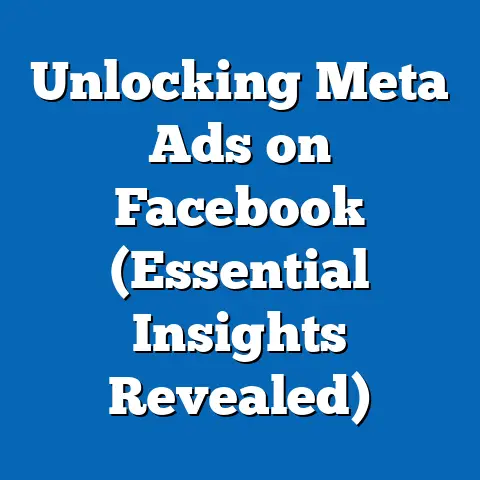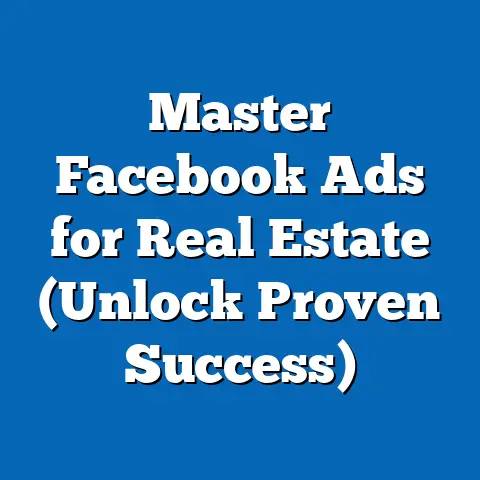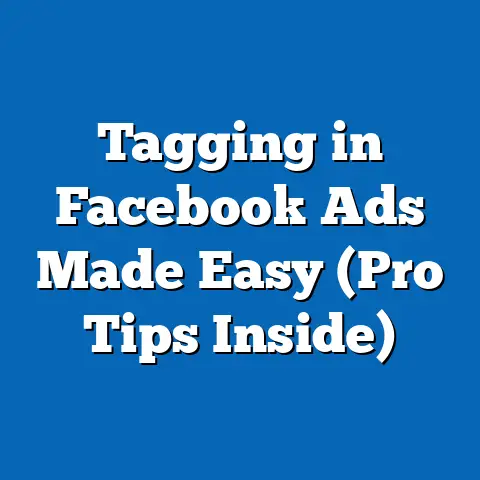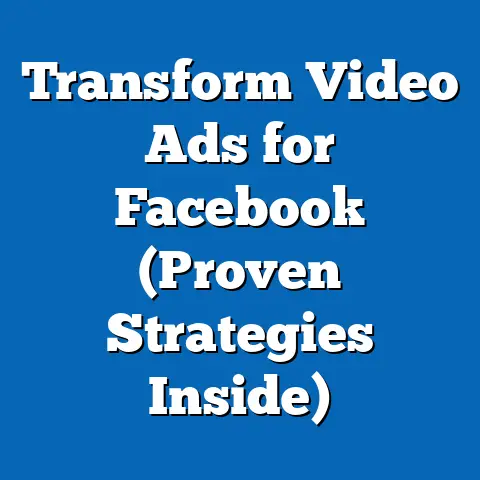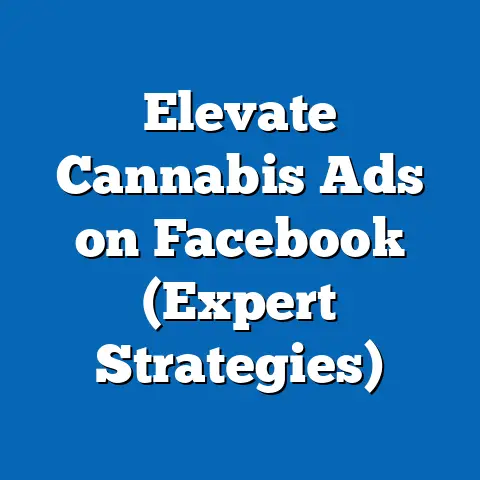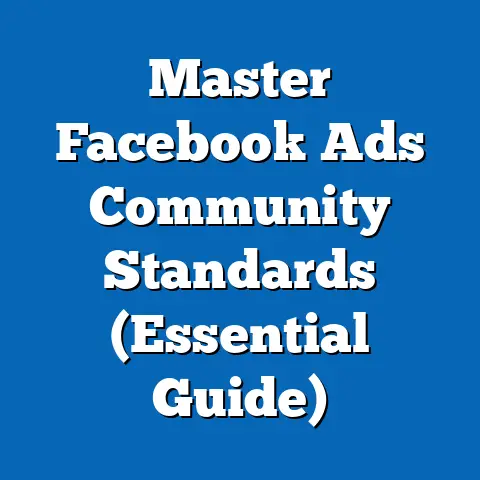Transform Facebook Ads Into Lead Magnets (Proven Strategies)
Let’s be honest, when we think of Facebook ads, the first word that springs to mind isn’t usually “warmth.” We often picture them as cold, calculated, and purely transactional. But what if I told you that you could completely transform your Facebook ads into powerful lead magnets simply by injecting a little warmth and authenticity?
In the world of digital marketing, “warmth” is all about creating genuine connections with your audience. It’s about fostering emotional engagement, building brand loyalty, and ultimately, influencing their decision-making process in a positive way. When potential customers feel a sense of warmth towards your brand, they’re far more likely to convert. It’s why I always prioritize building rapport and trust through my marketing efforts.
This article is all about flipping the script on traditional Facebook advertising. We’re going to dive deep into proven strategies that will help you infuse warmth into your ads, turning them into irresistible lead magnets that attract, engage, and convert. Get ready to ditch the cold, impersonal approach and start building real connections with your audience!
Section 1: Understanding Lead Magnets
Before we get into the nitty-gritty of transforming your Facebook ads, let’s make sure we’re all on the same page about what a lead magnet actually is.
A lead magnet is essentially a valuable resource that you offer to potential customers in exchange for their contact information, typically their email address. The purpose of a lead magnet is to attract and capture qualified leads by providing immediate value upfront. Think of it as a “bribe” – but a good one! You’re offering something genuinely useful in exchange for the opportunity to nurture a relationship.
There’s a whole buffet of lead magnet options out there, catering to different industries and audience needs. Here are a few common examples:
- eBooks: In-depth guides on specific topics.
- Webinars: Live or recorded presentations offering expert insights.
- Free Trials: Access to a product or service for a limited time.
- Checklists: Actionable lists that help users accomplish a specific task.
- Templates: Ready-to-use documents or designs.
- Discount Codes: Exclusive savings on products or services.
The key to a successful lead magnet is relevance. It needs to be highly relevant to your target audience’s interests and needs, and it should solve a specific problem or offer a valuable benefit.
Now, you might be thinking, “Okay, I get what a lead magnet is, but what does this have to do with Facebook ads?” Well, Facebook ads are an incredibly powerful medium for promoting your lead magnets. They allow you to reach a vast and highly targeted audience, driving traffic to your landing page where people can sign up to receive your valuable offer.
Takeaway: A lead magnet is a valuable resource offered in exchange for contact information, and Facebook ads are a powerful tool for promoting them.
Section 2: The Role of Facebook Ads in Lead Generation
So, why choose Facebook ads for lead generation? I’ve found that Facebook offers a unique blend of advantages that make it an ideal platform for attracting and capturing leads:
- Targeting Capabilities: Facebook’s unparalleled targeting options allow you to laser-focus your ads on specific demographics, interests, behaviors, and even custom audiences based on your existing customer data. This means you can ensure your lead magnet is seen by the people who are most likely to be interested in it. I’ve used custom audiences to target past website visitors and email subscribers, significantly boosting my conversion rates.
- Audience Reach: With billions of active users, Facebook provides access to a massive pool of potential leads. No matter your niche, you’re likely to find a significant portion of your target audience on the platform.
- Cost-Effectiveness: Compared to other advertising channels, Facebook ads can be incredibly cost-effective, especially when you optimize your campaigns for lead generation. I’ve seen campaigns generate leads for as little as a few dollars each, which is a fraction of what it would cost through traditional methods.
It’s important to understand the difference between traditional advertising and lead generation ads. Traditional ads often focus on brand awareness or direct sales, while lead generation ads are specifically designed to capture contact information.
Facebook offers a dedicated lead generation ad format that makes it incredibly easy for users to sign up for your offer without even leaving the platform. These ads include a built-in form that pre-populates with the user’s information, making the sign-up process seamless and frictionless.
Another crucial concept to grasp is audience segmentation and personalization. By segmenting your audience based on their interests, demographics, and behaviors, you can create highly personalized ads that resonate with them on a deeper level. For example, if you’re offering a free eBook on social media marketing, you can target your ads to people who have expressed interest in social media, marketing, or online advertising.
Takeaway: Facebook ads offer powerful targeting, broad reach, and cost-effectiveness for lead generation. Audience segmentation and personalization are key to creating effective campaigns.
Section 3: Proven Strategies to Infuse Warmth into Facebook Ads
Now for the heart of the matter: how do we actually inject that much-needed warmth into our Facebook ads? Here are some proven strategies that I’ve used to transform cold, transactional ads into genuine lead magnets:
Crafting Empathetic Messaging
Empathy is the foundation of any successful marketing strategy, and it’s especially crucial when it comes to lead generation. Before you even start writing your ad copy, take the time to truly understand your audience’s pain points and desires. What are their biggest challenges? What are their aspirations?
Once you have a clear understanding of their needs, you can craft messaging that resonates with them on an emotional level. Use language that shows you understand their struggles and that you’re genuinely there to help.
For example, instead of saying “Download our free eBook on social media marketing,” try something like “Tired of struggling to get results from your social media efforts? Our free eBook will show you the proven strategies you need to succeed.”
The key is to focus on the benefits of your lead magnet, not just the features. Explain how it will solve their problems, make their lives easier, or help them achieve their goals.
Using Storytelling Techniques
Storytelling is one of the most powerful tools in a marketer’s arsenal. It’s a way to create an emotional connection with your audience, build trust, and make your message more memorable.
Instead of simply listing the features of your lead magnet, try weaving a personal anecdote or customer success story into your ad copy. Share a story about how your lead magnet helped someone overcome a challenge or achieve a goal.
For example, if you’re offering a free webinar on time management, you could share a story about how you used to struggle with procrastination and overwhelm until you discovered the time management techniques you’ll be sharing in the webinar.
The more authentic and relatable your story, the more likely it is to resonate with your audience.
Incorporating Visuals that Evoke Emotion
Visuals play a crucial role in capturing attention and conveying emotion. When choosing images or videos for your Facebook ads, steer clear of generic stock photos and opt for visuals that reflect warmth, relatability, and authenticity.
Show real people, not just models. Use images that capture genuine emotions, such as joy, excitement, or even vulnerability. If you’re offering a service, show your team members interacting with customers or working on a project.
Videos can be particularly effective for conveying emotion. Consider creating a short video that tells a story, showcases your brand values, or features testimonials from satisfied customers. I’ve found that behind-the-scenes videos can be a great way to build trust and transparency.
Creating a Sense of Community
People are naturally drawn to communities, and creating a sense of belonging can be a powerful way to attract leads. Encourage interaction and feedback in the comments section of your ads. Ask questions, run polls, or invite people to share their experiences.
Respond to comments and engage in conversations. Show that you’re genuinely interested in what your audience has to say. This will help foster a sense of community and make people feel more connected to your brand.
You can also use your ads to promote your Facebook group or other online communities. This is a great way to build a loyal following and nurture leads over time.
Takeaway: Empathetic messaging, storytelling, emotional visuals, and community building are key to infusing warmth into your Facebook ads.
Section 4: Optimizing Facebook Ads for Lead Generation
Creating warm and engaging ads is only half the battle. You also need to optimize your campaigns for lead generation to ensure you’re getting the best possible results. Here are some key optimization strategies that I’ve found to be particularly effective:
Call-to-Action (CTA) Strategies
Your call-to-action (CTA) is the most important element of your ad. It’s the instruction that tells people what you want them to do. Make sure your CTA is clear, compelling, and action-oriented.
Instead of using generic CTAs like “Learn More” or “Sign Up,” try something more specific and benefit-driven, such as “Download Your Free Guide Now” or “Register for Our Free Webinar.”
Use strong action verbs that encourage immediate action, such as “Get,” “Download,” “Register,” or “Claim.”
A/B Testing is also a great way to test different CTAs to see which ones resonate best with your audience.
A/B Testing for Better Engagement
A/B testing, also known as split testing, is the process of comparing two versions of your ad to see which one performs better. You can A/B test different ad creatives, headlines, body copy, CTAs, and even targeting options.
The key is to test only one variable at a time so you can accurately measure the impact of each change. For example, if you’re testing two different headlines, keep everything else the same.
When analyzing your A/B test results, pay attention to metrics such as click-through rate (CTR), conversion rate, and cost per lead (CPL). These metrics will give you a clear indication of which version of your ad is generating the most leads at the lowest cost.
But don’t forget to gauge warmth and engagement. Look at metrics like comments, shares, and saves. Are people actively engaging with your ad? Are they sharing it with their friends? Are they saving it for later? These are all signs that your ad is resonating with your audience on an emotional level.
Utilizing Facebook Pixel for Retargeting
The Facebook Pixel is a small piece of code that you install on your website. It allows you to track the actions that people take on your website after clicking on your Facebook ad.
This data is incredibly valuable for retargeting. Retargeting allows you to show ads to people who have already interacted with your website or lead magnet. For example, you can retarget people who visited your landing page but didn’t sign up for your free eBook.
Retargeting is a powerful way to nurture leads and increase your conversion rates. You can use retargeting ads to remind people about your offer, provide additional information, or offer a special incentive to sign up.
Takeaway: Clear CTAs, A/B testing, and Facebook Pixel retargeting are essential for optimizing your Facebook ads for lead generation.
Section 5: Case Studies of Successful Lead Magnet Ads
Let’s take a look at a couple of real-world examples of brands that have successfully transformed their Facebook ads into lead magnets by incorporating warmth and authenticity:
Case Study 1: HubSpot
HubSpot, a leading marketing automation platform, is a master of lead generation. They consistently use Facebook ads to promote their free eBooks, guides, and templates.
What sets HubSpot’s ads apart is their focus on providing value and solving problems. Their ad copy is always clear, concise, and benefit-driven. They use visuals that are professional and engaging, and their CTAs are always strong and action-oriented.
HubSpot also does a great job of segmenting their audience and personalizing their ads. They target their ads to specific industries and job titles, and they tailor their messaging to address the unique challenges faced by each segment.
Case Study 2: Shopify
Shopify, a popular e-commerce platform, uses Facebook ads to promote their free trials and other lead magnets.
Shopify’s ads are known for their clean design, compelling visuals, and strong social proof. They often feature testimonials from satisfied customers, which helps build trust and credibility.
Shopify also does a great job of creating a sense of community. They encourage interaction and feedback in the comments section of their ads, and they respond to comments and questions promptly.
Takeaway: These case studies demonstrate that incorporating warmth, authenticity, and a focus on providing value can lead to significant improvements in lead generation results.
Conclusion
Transforming your Facebook ads into lead magnets is all about building genuine connections with your audience. By infusing warmth, empathy, and authenticity into your ad copy, visuals, and overall messaging, you can attract more leads, build stronger relationships, and ultimately drive more conversions.
Remember to focus on understanding your audience’s pain points and desires, using storytelling techniques to create an emotional connection, choosing visuals that evoke emotion, and fostering a sense of community.
Don’t forget to optimize your campaigns for lead generation by using clear CTAs, A/B testing different ad creatives, and utilizing the Facebook Pixel for retargeting.
The power of genuine engagement in digital marketing cannot be overstated. By implementing these strategies, you can transform your Facebook ads from cold, impersonal messages into warm, welcoming invitations that attract and engage your ideal customers. So go ahead, give it a try, and watch your lead generation results soar!

